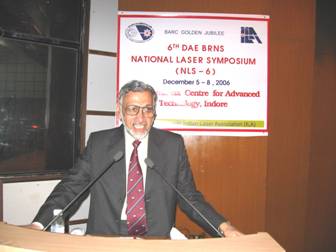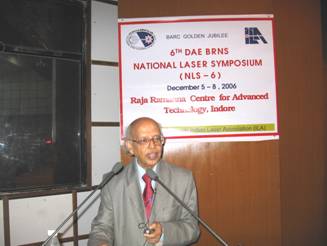A special issue of "Kiran, the Bulletin of Indian Laser Association" consisting of the extended abstracts of the invited talks presented in the technical sessions was brought out at the time of the symposium and distributed to the participants.
All the contributed papers in the NLS-6, totaling 240, were presented in the Poster Sessions on the first three days of the symposium. All these papers have been compiled in a CD, which was distributed to all the participants at the time of the registration.
Three special lectures were arranged in the evenings. On the first day, Prof. Govind Swarup of NCRA, Pune, delivered a talk on "New challenges in the fields of science and technology in India: lessons from the GMRT". On the third day, Dr. A. M. Patankar of BARC, explained the importance of patents, and its role as a catalyst for R&D. This was followed by a talk by Dr. A. K. Nath of RRCAT, who presented the development and industrial applications of carbon-dioxide and Nd-YAG Lasers.
The first session on the last day of the symposium was devoted to thesis presentations. A total of seven theses were presented. A panel of judges was formed to assess the thesis work in terms of quality, and quantity of work, and its presentation by the candidate and select the best thesis the award.
This was followed by the concluding session, which was co-organized by the ILA. Shri U.Nundy, Convener NLS-06, gave a brief review of the symposium. Dr. P.D.Gupta, President, ILA addressed the audience with the details of the activities and the achievements of ILA. He also presented the "Best thesis" awards to P.K.Mukhopadhyay (RRCAT, Indore), Sourabh Mukhopadhyay (IIT, Kharagpur), A.K.Sharma (RRCAT, Indore) and Atul Shrivastava (IIT, Kanpur). Shri U. Nundy gave away the "Best Poster" awards.
Two cultural programs were arranged during the Symposium. On the first day Dr. Suchitra Harmalkar presented a programme on "Kathak Dance". On the third day, local artists of RRCAT presented a "Boquet of Songs" to the participants. Both the programmes were highly appreciated by the participants.
As in earlier years, the response to the symposium was overwhelming. About 260 papers were received of which 240 papers were accepted for poster presentation after review. There were 442 registered participants which included 165 students. Some collaborative work plans between institutes outside DAE and DAE institutes have been initiated, following the discussions that had taken place during the symposium.
On the whole, the symposium achieved its aim of bringing together researchers and students of the laser community together in one platform and act as a catalyst for increased interaction and cooperation among the delegates.















